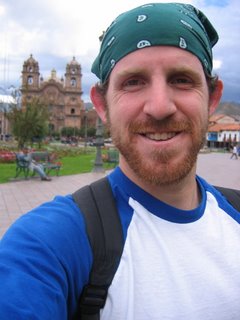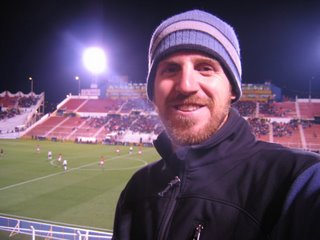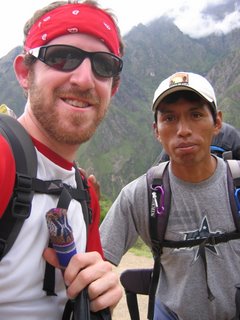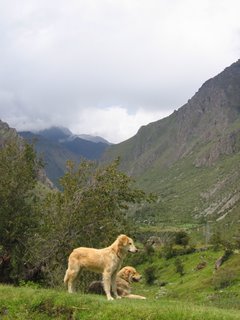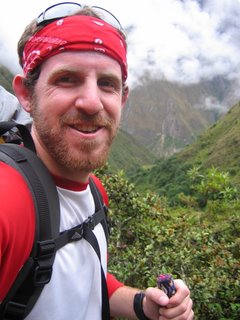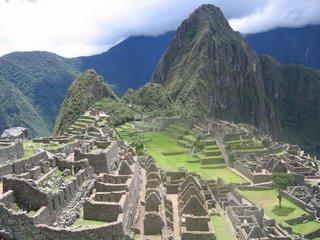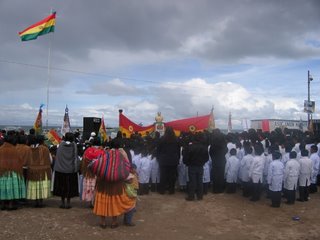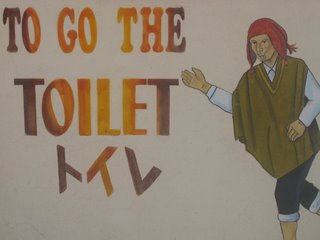
Day two of the Inca Trail is traditionally the day from hell. However, if you ask most anyone who began the hike on March 16th, 2006, they'd likely tell you that it was day three that had them questioning the existence of God. From the moment we woke up to about an hour and a half before reaching camp, water came down from the skies as though it would never stop. Such is life during the Andean rainy season. That said, I believe it says a lot about this experience that the trail and the challenge continued to be enjoyable. We couldn't see much scenery through the low clouds that swept in and covered the mountain, but we still felt like we were a part of something truly amazing. It was that, or the altitude high.

Over the past three days we had passed by and through several different Inca sites of varying size and majesty. All were interesting in their own rite, but, for me, it wasn't until we reached the Wiñay Huayna ruins at camp three that the history of this entire civilization burst into life. Though the sun had finally come up to warm the skies, we were still cold, wet, and terrifically exhausted, and it took every ounce of drive within us to drag our sorry butts just those few hundred feet
past our campsite to see this magnificent site. Clearly, it was worth the extra effort. Like a schoolboy who finally found a subject he liked, I began rattling off questions for Flavio at an excited pace. What is this? What is that? How did they make those? In a single moment's glance, this whole thing became very real to me.

In trying to determine what made Wiñay Huayna stand out among all the other ruins I had seen thus far, I determined that it came down to one or more of the following: grandeur, space, and mental insanity. By and large, this site was just massive. With terraces lining the depth of the hill, falling down from the main structures, Wiñay Huayna fills your entire frame of your vision - it's big and it's grand. From within the ruins, standing behind one of the windows, you can look out on the furthest mountains leading out from the river below. That space creates a feeling of superiority, as though you might very well control the entire region before you - distance creating majesty. Of course, as completely exhausted as we were, it's also just possible that I could have found a medium-sized cardboard box to be the kingdom of heaven.

While the ruins, here, were all fine and good, it's worth stepping back for a moment to note that today's hike was, at times, just as daunting as the second day. Starting with some challenging uphill climbs through the pouring rain, we finally reached another pass that finally indicated the beginning of our long-awaited downward ascent. However, this is no easy task. Extended drop-offs, lined with slippery rocks, make the final stages of the day difficult on the knees. This is where your walking stick really begins to pay off in spades. The end, leading right into camp, is a series of stairs that, sort of without you even realizing it, beats the hell out of your legs. But, like I've already mentioned, it's all worth it when you get to Wiñay Huayna.
Starting altitude: 11,646 feet (3,550 meters) Peak Altitude: 13,123 feet (4,000 meters) Camp Altitude: 8,792 feet (2,680 meters) Total Distance: 9.3 miles (15 km)

After two days of rain, we were all thoroughly soaked to the bone - our tents became poorly functioning dry lines. Still, no matter how wet and nasty we were feeling, and no matter how long we had gone without a good shower, there was always something really nice about showing up into camp to find bars of soap with buckets of hot, clean water for washing our face and hands. There
were actual pay showers available to hikers at the third camp, but I was just as content to skip the long lines and splash myself down from the bucket on the ground. Then I chased my tail for twenty minutes and gnawed on a tennis ball.

After dinner with a little wine, we presented our cook and porters with their tip. Then the girls sang them a traditional Swedish song which may or may not have been about getting drunk. I really don't know. The porters returned the honor by singing us a traditional Andean tune which, for as best as we could tell, may or may not have been about hating wealthy foreigners who pack too much crap for a four-day hike. Since the only traditional American song I could think of that had anything to do with expressing gratitude was that horrible Whitney Houston song from
The Bodyguard, I chose to remain silent. But I did do a lot of clapping...

The third night of the Inca Trail tends to be a rather special evening. Having completed all the really hard parts - all the giant uphill battles through horrible weather and dizzying altitudes - hikers are treated to, well, a bar. From day one, you end up passing, being passed by, and dining close to numerous other adventurers taking on this experience with different companies. While you never really get to know them as closely as you get to know the people in your own group, there's still sort of this shared sense of camaraderie. Perhaps it's just a quick glance at another tired backpacker that says, "I can't believe we paid to f-----g do this." But however small those connections may be, there's no greater catalyst for conversation and renewed spirits than cheap beer and bad salsa music. It's not a terribly late evening (everyone has to be up at 4am), but it's great to finally let loose a little with all the other travelers, your guide, and any porters who might wander into the cantina hoping for a complimentary drink... on you. Seriously, though, if anyone deserves a cold cerveza, it's the porters. Me and the girls ended up closing the bar down at 10:30pm. Yeah, we're pretty hard core.

I've included this picture for no other reason but to humiliate Helen and Anna.
Peru Home & Sidebar
Previous Day -- Next Day
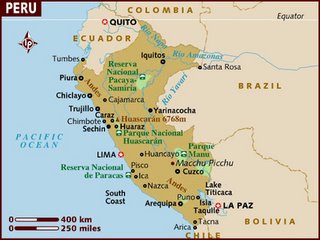 I can't say for certain why I felt so compelled to visit Machu Picchu. After all, going into this trip I knew very little history of the lost city of the Incas and even less about the people who once called it home. But, for whatever reason, it just kept calling me there. I suppose it's sort of like the Crosby Stills & Nash song, Southern Cross, which rejoices: "When you see the Southern Cross for the first time you understand now why you came this way." I decided to come this way in the middle of March, opting to take my chances toward the end of the region's rainy season. Just like anything else, this time of year has its pros and cons. On the positive side, there are considerably less tourists crawling over the ruins, the weather is a little warmer, and the mountainside is clean and green. In fact, the trail is actually closed throughout the entire month of February so repairs and upkeep can be done while the summer downpours give life to the flora and fauna. Prices during this part of the year are also discounted by most agencies, allowing some long-term travelers (who aren't strapped for time) to acquire great deals in Cuzco without pre-booking over the internet. Of course, the major drawback of hitting the trail in March is that it's wet. Very wet. Nevertheless, with only two weeks of travel away from work, I concentrated on the positives, visiting not only Machu Picchu, but also Lake Titicaca's Bolivian shore, Arequipa, and Lima. I hope that the information presented here will help others in their travels to understand why they came this way. (map: www.lonelyplanet.com)
I can't say for certain why I felt so compelled to visit Machu Picchu. After all, going into this trip I knew very little history of the lost city of the Incas and even less about the people who once called it home. But, for whatever reason, it just kept calling me there. I suppose it's sort of like the Crosby Stills & Nash song, Southern Cross, which rejoices: "When you see the Southern Cross for the first time you understand now why you came this way." I decided to come this way in the middle of March, opting to take my chances toward the end of the region's rainy season. Just like anything else, this time of year has its pros and cons. On the positive side, there are considerably less tourists crawling over the ruins, the weather is a little warmer, and the mountainside is clean and green. In fact, the trail is actually closed throughout the entire month of February so repairs and upkeep can be done while the summer downpours give life to the flora and fauna. Prices during this part of the year are also discounted by most agencies, allowing some long-term travelers (who aren't strapped for time) to acquire great deals in Cuzco without pre-booking over the internet. Of course, the major drawback of hitting the trail in March is that it's wet. Very wet. Nevertheless, with only two weeks of travel away from work, I concentrated on the positives, visiting not only Machu Picchu, but also Lake Titicaca's Bolivian shore, Arequipa, and Lima. I hope that the information presented here will help others in their travels to understand why they came this way. (map: www.lonelyplanet.com)

